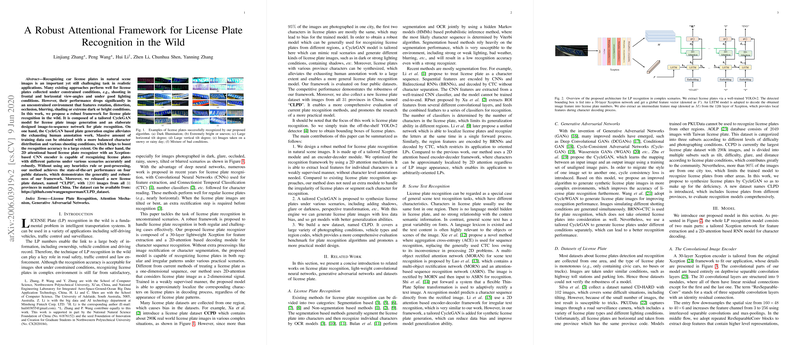The paper presents a robust framework for License Plate Recognition (LPR) in unconstrained environments, a key challenge in intelligent transportation systems. The proposed methodology integrates a Cycle-consistent Generative Adversarial Network (CycleGAN) for generating augmented training data and a Convolutional Neural Network (CNN) with a Recurrent Neural Network (RNN) that employs a 2D attentional mechanism for robust sequence decoding.
Key Components of the Framework:
- Data Augmentation with Asymmetric CycleGAN:
- The paper introduces a tailored version of CycleGAN to generate synthetic license plate images under diverse conditions such as varying illumination and perspective transformations. This addresses dataset biases, particularly regarding regional character distributions, and reduces annotation workload.
- Feature Extraction with Tailored Xception Module:
- The recognition framework employs a modified Xception model for feature extraction. This model effectively captures both global and local features from license plate images, preparing them for sequence decoding.
- Sequence Decoding via 2D Attention-based RNN:
- The proposed method utilizes an RNN with a 2D attention mechanism, which allows the model to handle irregularities and distortions in license plate images without relying on pre-segmentation or image rectification. This approach ensures attention is focused on relevant parts of the image for each character during the decoding process.
Experimental Results:
- The framework underwent extensive testing on multiple public datasets, including CCPD, AOLP, PKUData, and a newly introduced dataset named CLPD, which covers a diverse set of conditions and vehicle types across all Chinese provinces. On these benchmarks, the method achieved state-of-the-art recognition rates. Notably, adding synthetic data led to a substantial performance boost, particularly for rotated or tilted plates.
- The proposed framework was benchmarked against various state-of-the-art methods, consistently outperforming them, especially in scenarios where license plates are presented in challenging perspectives or illuminate poorly. Specific improvements were noted in subsets with highly variable conditions, such as those labeled "Rotate" and "Weather".
- The implementation allowed for end-to-end training without requiring pre-processing steps like character segmentation or image rectification, marking an advantage over traditional methods that are often hindered by distortions and diversions in complex environments.
Contributions and Implications:
- Broad applicability: The research introduces an adaptable LPR framework applicable to various real-world environments. This versatility is largely due to the encapsulated attention mechanism and data augmentation strategy.
- Efficient Data Synthesis: By leveraging AsymCycleGAN, the paper addresses the limitations of traditional CycleGAN in generating realistic and varied license plate images, enhancing the generalization of trained models across diverse conditions.
- Dataset Introduction: The paper presents the CLPD dataset, which significantly enriches the research community’s resources by providing a diverse set of real-world license plate images covering all provinces in China, instrumental for benchmarking LPR systems.
In conclusion, the paper makes significant strides in advancing LPR capabilities under challenging conditions by integrating modern machine learning techniques. Its contribution to robust recognition, despite variable and adverse conditions, marks a pivotal enhancement for applications in intelligent transportation systems and beyond.
